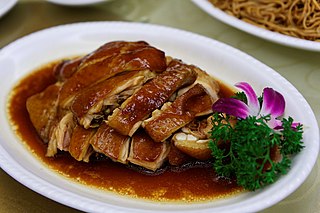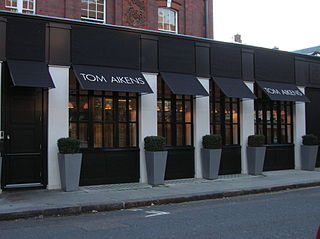
Cantonese or Guangdong cuisine, also known as Yue cuisine, is the cuisine of Guangdong province of China, particularly the provincial capital Guangzhou, and the surrounding regions in the Pearl River Delta including Hong Kong and Macau. Strictly speaking, Cantonese cuisine is the cuisine of Guangzhou or of Cantonese speakers, but it often includes the cooking styles of all the speakers of Yue Chinese languages in Guangdong.

Teochew cuisine, also known as Chiuchow cuisine, Chaozhou cuisine or Teo-swa cuisine, originated from the Chaoshan region in the eastern part of China's Guangdong Province, which includes the cities of Chaozhou, Shantou and Jieyang. Teochew cuisine bears more similarities to that of Fujian cuisine, particularly Southern Min cuisine, due to the similarity of Teochew's and Fujian's culture, language, and their geographic proximity to each other. However, Teochew cuisine is also influenced by Cantonese cuisine in its style and technique.
Taiwanese cuisine is a popular style of food with several variations, including Chinese and that of Taiwanese indigenous peoples, with the earliest cuisines known of being the indigenous ones. With over a hundred years of historical development, mainstream Taiwanese cuisine has been influenced by Hakka cuisine, the cuisines of the waishengren, Japanese cuisine, and American cuisine, with southern Fujian cuisine having had the most profound impact.

Chop suey is a dish from American Chinese cuisine and other forms of overseas Chinese cuisine, generally consisting of meat and eggs, cooked quickly with vegetables such as bean sprouts, cabbage, and celery, and bound in a starch-thickened sauce. It is typically served with rice, but can become the Chinese-American form of chow mein with the substitution of stir-fried noodles for rice.

Dim sum is a large range of small Chinese dishes that are traditionally enjoyed in restaurants for brunch. Most modern dim sum dishes are commonly associated with Cantonese cuisine, although dim sum dishes also exist in other Chinese cuisines. In the tenth century, when the city of Canton (Guangzhou) began to experience an increase in commercial travel, many frequented teahouses for small-portion meals with tea called "yum cha" (brunch). "Yum cha" includes two related concepts. The first is "jat zung loeng gin", which translates literally as "one cup, two pieces". This refers to the custom of serving teahouse customers two delicately made food items, savory or sweet, to complement their tea. The second is dim sum, which translates literally to "touch the heart", the term used to designate the small food items that accompanied the tea.

Soy sauce chicken is a traditional Cantonese cuisine dish made of chicken cooked with soy sauce. It is considered as a siu mei dish in Hong Kong.

Manti is a type of dumpling mainly found in Turkish cuisine, Armenian cuisine and Central Asian cuisine but also in West Asia, South Caucasus, and the Balkans. Manti is also popular among Chinese Muslims, and it is consumed throughout post-Soviet countries, where the dish spread from the Central Asian republics. The dumplings typically consist of a spiced meat mixture, usually lamb or ground beef, wrapped in a thin dough sheet which is then boiled or steamed. The size and shape of manti vary significantly depending on geographic location.

Chez Bruce is a restaurant located at 2 Bellevue Road in Wandsworth, London, England.

Korean Chinese cuisine, also known as Sino–Korean cuisine, is a hybrid cuisine developed by the ethnic Chinese in Korea.

Japanese Chinese cuisine, also known as chūka, represents a unique fusion of Japanese and Chinese culinary traditions that have evolved over the late 19th century and more recent times. This style, served predominantly by Chinese restaurants in Japan, stands distinct from the "authentic Chinese food" found in areas such as Yokohama Chinatown. Despite this difference, the cuisine retains strong influences from various Chinese culinary styles, as seen in the shippoku cooking style.

Tom Aikens was a London Michelin-starred fine dining restaurant operated by the eponymous chef from April 2003 opening to January 2014 closure. The restaurant received mostly positive critical reception.
Kai Mayfair is a fine dining Chinese restaurant located on 65 South Audley Street, Mayfair, near Park Lane in London, England. It was opened in 1993 by Malaysian sport shooter; Bernard Yeoh, with the intent of changing the perception of the Chinese restaurant experience. Yeoh was keen to show that Asian food has just as much standing in the fine-dining circuit as other cuisines. The head chef is Alex Chow, while Yeoh continues to be the proprietor to this day.

Shark fin dumpling is a dim sum dish in Hong Kong. It is a form of Dumpling in Superior Soup, a dumpling with gelatinous broth inside. As with shark fin soup, the shark fin content is often replaced with an imitation.

Dandan noodles or dandanmian, literally "carrying-pole noodles", is a noodle dish originating from Chinese Sichuan cuisine. It consists of a spicy sauce usually containing preserved vegetables, chili oil, Sichuan pepper, minced pork, and scallions served over noodles. The dish can either be served dry or as a noodle soup.

Jiaozi are a type of Chinese dumpling. Jiaozi typically consist of a ground meat and/or vegetable filling wrapped into a thinly rolled piece of dough, which is then sealed by pressing the edges together. Finished jiaozi can be boiled, steamed, pan-fried, or deep-fried, and are traditionally served with a black vinegar and sesame oil dip. They can also be served in a soup.
The Restaurant Marco Pierre White, also known as The Restaurant, Restaurant Marco Pierre White and later Oak Room Marco Pierre White, was a restaurant run by chef proprietor Marco Pierre White. The Restaurant was opened at the Hyde Park Hotel, London, on 14 September 1993, after White left his previous restaurant, Harveys. Following the move, the kitchen staff was more than doubled in number, and White used Pierre Koffmann's La Tante Claire as a template to pursue his third Michelin star. This was awarded in the 1995 Michelin guide. White then moved the restaurant to the Le Méridien Piccadilly Hotel, London, in 1997, taking on the listed Oak Room as the main dining room. He sought a further rating of five red forks and spoons in the guide, to gain the highest possible rating for the restaurant. It gained this award in the following guide.

Australian Chinese cuisine is a style of cooking developed by Australians of Chinese descent, who adapted dishes to satisfy local Anglo-Celtic tastes. Its roots can be traced to indentured Chinese who were brought to work as cooks in country pubs and sheep stations.

Elystan Street is a London restaurant co-owned by chef patron Phil Howard and Rebecca Mascarenhas. Howard and Mascarenhas established the restaurant on 27 September 2016, six months after Howard sold and left his previous restaurant The Square. Elystan Street earned its first Michelin star in October 2017 and has retained it since.

Ocean City Seafood Restaurant was a Chinese restaurant in Portland, Oregon.














